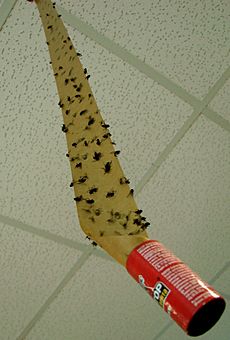Flypaper facts for kids
Flypaper, also known as a fly ribbon or fly strip, is a simple tool used to catch flies and other flying insects. It is usually a strip of paper covered with a very sticky, sweet-smelling glue. When insects land on it, they get stuck and cannot fly away. Flypaper is a type of pest control device. In some countries, like the United States, how flypaper is made and sold is regulated by laws.
Is Flypaper Safe?
Long ago, some types of flypaper contained poisons that could be harmful to people and animals. For example, a dangerous substance called arsenic was sometimes used.
But don't worry! Most flypaper sold today is much safer. It usually does not have any poisons. Instead, it uses a special sticky glue, like a material called rosin, to trap insects. This glue is not harmful to humans or pets.
How Well Does Flypaper Work?
Flypaper can be just as good at catching insects as other methods, like using bug sprays (called insecticides) or bug zappers. However, some people do not like how a sticky strip of flypaper looks hanging from the ceiling. Because of this, flypaper is not as common as it once was.
Some types of flypaper might also have a slight smell that some people find unpleasant. Handling and throwing away flypaper can be a bit tricky because it is so sticky. If you get the glue on your hands, you can often remove it with vegetable oil.
Flypaper does not last forever. It loses its stickiness over time, especially if it gets dusty or dries out. So, it is important to replace it regularly. Where you hang the flypaper also matters; it might work better in some spots in a room than others.
See also
 In Spanish: Papel atrapamoscas para niños
In Spanish: Papel atrapamoscas para niños


